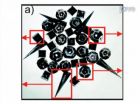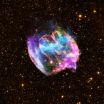(Press-News.org) CAMBRIDGE, Mass. (February 13, 2013) – Whitehead Institute researchers have identified a previously unrecognized layer of genetic regulation that is necessary for the generation of undesirable white fat cells. When this regulation is disrupted, white fat cells are unable to accumulate lipid droplets or mature from their precursors.
"We're trying to figure out what the mechanism is—what it takes to make fat cells," says Whitehead Founding Member Harvey Lodish, who is also a professor of biology and a professor of bioengineering at MIT. "The obvious reason we're interested in this is because a lot of people have too many of them."
According to the Centers for Disease Control and Prevention, obesity—having a body mass index (BMI) of 30 or higher—is a serious healthcare and economic problem in the United States. More than one-third of American adults are obese, a condition that can lead to heart disease, type 2 diabetes, and stroke. In 2008 obesity-related issues were estimated to cost $147 billion.
All of these problems are caused by an overabundance of white fat cells—adipose tissue cells that store excess energy as fat or lipid droplets. Unlike white fat cells, brown fat cells, which are most prevalent in babies and have a reduced presence in adults, use lipids as fuel to maintain a stable, warm body temperature. Understanding how both types of fat cells are formed and maintained may one day lead to anti-obesity therapies.
In the quest to understand fat-cell generation and maintenance, the Lodish lab scanned mouse fat cells to determine which of the cells' long noncoding RNAs (lncRNAs) are active. Of the 175 identified, 10 lncRNAs were found to play significant roles in these cells.
Residing within what was once dubbed "junk DNA", lncRNAs have recently gained fame as important gene expression regulators that modify chromatin, enhance transcription, and promote messenger RNA (mRNA) degradation, as well as through other methods that have yet to be elucidated. Recently, the Lodish lab identified lncRNAs as playing a vital role in regulating programmed cell death during one of the final stages of red blood cell differentiation.
To determine the function of the identified active lncRNAs in fat cells, Lei Sun, a former postdoctoral researcher in the Lodish lab, and Loyal Goff from Harvard University and the Broad Institute, knocked each lncRNA down individually in fat precursor cells and analyzed the results. When 10 of these lncRNAs had reduced expression, the cells did not turn on the genes that are usually expressed in mature white fat cells, and the cells had significantly smaller lipid droplets than white fat cells with normal lncRNA expression. Their work is reported in this week's issue of the Proceedings of the National Academy of Sciences (PNAS).
"This is the first study showing the importance of lncRNAs for the regulation of adipogeneis," says Sun, who is now an assistant professor at Duke-NUS Graduate Medical School. "Our understanding of lncRNA function in these cells is still incomplete, but in the future, this line of research may reveal new pathways that obesity drugs could target."
###
This research was supported by National Institutes of Health (DK047618, DK068348, 5P01HL066105, and 1DP2OD00667), National Science Foundation, Damon Runyon Cancer Research Foundation, Agency of Science, Technology and Research, Singapore, Searle Scholars Program, Smith Family Awards Program, and Merkin Family Foundation.
Written by Nicole Giese Rura
Harvey Lodish's primary affiliation is with Whitehead Institute for Biomedical Research, where his laboratory is located and all his research is conducted. He is also a professor of biology and a professor of bioengineering at Massachusetts Institute of Technology.
Full Citation:
"Long noncoding RNAs regulate adipogenesis"
PNAS, online the week of February 11, 2013.
Lei Sun (a,1), Loyal A. Goff (b,c,d,1), Cole Trapnell (b,c,1), Ryan Alexander (a,d), Kinyui Alice Lo (a,d), Ezgi Hacisuleyman (b,e), Martin Sauvageau (b,c,e), Barbara Tazon-Vega (b,c), David R. Kelley (b,c), David G. Hendrickson (b,c), Bingbing Yuan (a), Manolis Kellis (c,d), Harvey F. Lodish (a,f,g), and John L. Rinn (b,c,e).
a. Whitehead Institute for Biomedical Research, Cambridge, MA 02142
b. Stem Cell and Regenerative Biology, Harvard University, Cambridge, MA 02138
c. The Broad Institute of Massachusetts Institute of Technology and Harvard, Cambridge, MA 02142
d. Computer Science and Artificial Intelligence Laboratory, Massachusetts Institute of Technology, Cambridge, MA 02139
e. Molecular and Cellular Biology, Harvard University, Cambridge, MA 02138
f. Department of Biology, Massachusetts Institute of Technology, Cambridge, MA 02139
g. Department of Biological Engineering, Massachusetts Institute of Technology, Cambridge, MA 02139
1. These authors contributed equally to this work.
Long noncoding RNAs control development of fat cells
2013-02-13
ELSE PRESS RELEASES FROM THIS DATE:
For some, deep brain stimulation brings lasting improvement in neuropathic pain
2013-02-13
Philadelphia, Pa. (February 13, 2013) – For many patients with difficult-to-treat neuropathic pain, deep brain stimulation (DBS) can lead to long-term improvement in pain scores and other outcomes, according to a study in the February issue of Neurosurgery, official journal of the Congress of Neurological Surgeons. The journal is published by Lippincott Williams & Wilkins, a part of Wolters Kluwer Health.
About two-thirds of eligible patients who undergo DBS achieve significant and lasting benefits in terms of pain, quality of life, and overall health, according to the ...
Busy beavers give Canada geese a lift, study shows
2013-02-13
A new University of Alberta study shows that busy beavers are helping Canada geese get an earlier start when the birds fly home and begin spring nesting.
Ponds in Alberta where beavers were active tended to result in earlier thaw of winter snowpack, giving the geese a better chance at reproductive success, according to the study, published recently in Mammalian Biology.
The study is the first to link beavers to early season nesting habits of Canada geese in a Northern climate.
A team led by Glynnis Hood, an associate professor in the Department of Science at the ...
'Masked' mold toxins in food should be included in safety regulations
2013-02-13
Government limits on mold toxins present naturally in grain crops should be expanded to include so-called "masked mycotoxins" that change from harmless to potentially harmful forms in the body, a new study concludes. It appears in ACS' journal Chemical Research in Toxicology.
Chiara Dall'Asta and colleagues explain that molds growing naturally on wheat, corn and other plants produce toxic substances termed mycotoxins. Some health experts regard mycotoxins as the most serious chronic dietary risk factor, greater than the potential health threats from pesticides and insecticides. ...
Origami meets chemistry in scholarly video-article
2013-02-13
February 13, 2013
Cambridge, MA: The nanotechnology research space is rapidly growing, with vast implications for the healthcare, consumer electronics, surveillance, and defense industries. However, a major limitation to this research is the ability to create particles that vary in shape and function on a micrometer or nanometer scale.
To overcome these limitations, chemical engineers at Johns Hopkins University have developed self-assembling particles that are inspired by origami, the traditional Japanese art of folding paper into complex three-dimensional shapes. ...
A cooler way to protect silicon surfaces
2013-02-13
CAMBRIDGE, MA -- Silicon, the material of high-tech devices from computer chips to solar cells, requires a surface coating before use in these applications. The coating "passivates" the material, tying up loose atomic bonds to prevent oxidation that would ruin its electrical properties. But this passivation process consumes a lot of heat and energy, making it costly and limiting the kinds of materials that can be added to the devices.
Now a team of MIT researchers has found a way to passivate silicon at room temperature, which could be a significant boon to solar-cell ...
Protein central to cancer stem cell formation provides new potential target
2013-02-13
HOUSTON - Researchers have identified a pivotal protein in a cellular transformation that makes a cancer cell more resistant to treatment and more capable of growing and spreading, making it an inviting new target for drug development.
Additionally, the international team led by scientists at The University of Texas MD Anderson Cancer Center found the cancer drug sunitinib potentially has a new role in treating triple-negative, claudin-low breast cancer, a particularly resistant version of a type of cancer that is already difficult to treat.
"We found that FOXC2 lies ...
NASA's Chandra suggests rare explosion created our galaxy's youngest black hole
2013-02-13
New data from NASA's Chandra X-ray Observatory suggest a highly distorted supernova remnant may contain the most recent black hole formed in the Milky Way galaxy. The remnant appears to be the product of a rare explosion in which matter is ejected at high speeds along the poles of a rotating star.
The remnant, called W49B, is about a thousand years old as seen from Earth and located about 26,000 light-years away.
"W49B is the first of its kind to be discovered in the galaxy," said Laura Lopez, who led the study at the Massachusetts Institute of Technology. "It appears ...
By guessing, clinicians may miss 3/4 of alcohol problems
2013-02-13
SAN ANTONIO, Texas (Feb. 13, 2013) — By relying on hunches rather than posing a few screening questions, primary care clinicians may be missing three-fourths of the alcohol problems in their patients, a newly released analysis shows.
"It's often off the radar — people come in for hypertension and are not asked how much they drink," said study co-author Barbara J. Turner, M.D., M.S.Ed., M.A., M.A.C.P., of UT Medicine San Antonio. Primary care offices typically don't have good systems to administer questionnaires to screen for certain problems, including alcohol consumption, ...
Tube versus IV feeding in malnourished pediatric cancer patients
2013-02-13
About 60 percent of pediatric cancer patients experience malnourishment during treatment. At that point, patients and families have a choice: tube feeding or IV nutrition supplement. Which would you choose? A study published this week in the Journal of Pediatric Oncology Nursing shows that families' perceptions, especially of the discomfort of tube feeding, leads to choosing IV over tube – despite the fact that tube feeding is usually the better choice, associated with better gut function and lower rates of infection.
"Despite the benefits of tube feeding, we found a ...
Key molecule suppresses growth of cancerous liver tumors, Mayo study finds
2013-02-13
ROCHESTER, Minn. -- A molecule already implicated in a number of diverse cellular functions can suppress the growth of tumors in the liver, a Mayo Clinic Cancer Center study has found. Its name is IQGAP1, and when the molecule is active in the cells that surround a tumor cell, this "tumor microenvironment" becomes less hospitable to cancer growth. When the molecule is deficient, cancer thrives.
Results of the study appear in the Journal of Clinical Investigation. The findings give new insight into cancer metastasis, the ability of a tumor to spread from its primary site ...


